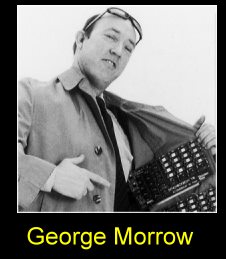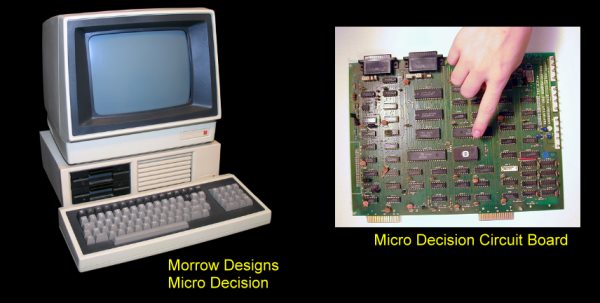
Morrow Designs - History

George Morrow was the founder of
Morrow's Micro Stuff & Morrow Designs but unlike some other S-100 computer companies his path was
a bit more indirect. In the mid 1970's he was a graduate student in mathematics
at Berkley and became interested in microcomputers and with two of his
friends, Chuck Grant and Mark Greenberg. They toyed with the idea of making
S-100 boards for the then new Altair computer. I guess they could not decide
exactly what to do because the tree split up. Grant and Goldberg went on to form
NorthStar
Computers in Berkley.
George got the idea of making a keyboard
driven
front panel board for 8080 driven Altair and IMASI computers.
Unfortunately it was not a big hit because it used Octal addressing (everybody
after Altair went with Hex addressing) and also because there was a rush toward z80
based systems.
After trying a few other things he
worked on a low cost 4K memory board and sold it to Bill
Godbout. The board was quit
reliable and popular. It was far better than the equivalent Altair 4K dynamic
RAM boards from
MITS. It sold well.

George then decided to actually start
his own company which he called Thinker Toys initially but later changed
it to Morrow's Micro Stuff, to sell his boards. It was
a time of rapid expansion in the fledging microcomputer industry. The demand for
cheap memory boards was almost impossible to fill. Companies like Morrows
Micro Stuff could not make boards fast enough. In 1977, George got side tracked
when
he joined up with a guy called Howard Fulmer (later VP of R&D at Morrow Designs) and
they put together an S-100 computer
which they called the Equinox-100. Unfortunately it was 8080 based. The 8 bit world was moving
rapidly towards the Z80. The system never
really took off.
Not to be stopped he then focused on an
S-100 floppy disk controller board complete with an 8" disk drive, cabinet ,
cables and most importantly CP/M software. Again he was at the right place at
the right time. It brought a very reasonable priced 8" floppy disk system to the
hobbyist. It was a great success and allowed him to build the company.
He returned to putting together a
complete computer systems and sold them as a package with a video
terminal. His company, Morrow's Micro Decisions, made a single circuit board
computer with 64K of RAM board, two serial ports, a parallel port and either one or two floppy disks. The video
terminal was made by a terminal manufacturer. The system was sold with CP/M, two
versions of BASIC, and an applications package that including WordStar, a
spreadsheet, and a financial analysis package. It looked like an IBM-PC on the
outside.
However when the IBM-PC with its 16 bit
system got going things started to change. Morrow actually made a MS-DOS 16 bit
system called the "Pivot". He had high hopes for the system.
However he lost out on a large US government (IRS) bid to Zenith Corp for large
volumes of the unit. The company never could completely recover. The company
actually had a number of names over time. It was called "Morrows MicroStuff"
"Thinker Toys", "Morrow Designs", "Discus" and Morrow Micro Designs".
George himself was one of the legendry
hero's of the S-100 era. He was an active member of many user groups and
probably was the person most responsible for the design, specification and
approval of the IEEE-696 standard. He was well known for his enthusiasm and his
sense of humor within the computer industry.
One interesting story -- In his early years, he was arrested for stealing
hubcaps and the judge gave him the choice - jail or the Army, he choose the
Army and while in the Army he opened up a store off base selling used power
supplies (illegal) - but that is how he got his start! Unfortunately George passed away in May 2003.
A sad loss to us all.

Morrow S-100 Boards
24K RAM
64K RAM
Disk Jockey FDC
Multi I/O
SuperRAM
SwitchBoard
Z80 Board
Hard Disk Controller
This page was last modified
on
01/08/2011


![]()

